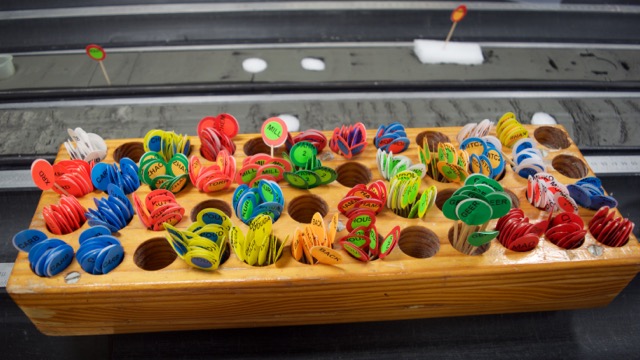
Sampling Sampler
After the core comes on deck at the catwalk and whole-round samples are taken for fossils and chemistry, it comes indoors for the rest of its life. Then measurements and sampling really get underway.
The story of core from catwalk to description table is a post for another time. Today (Sunday morning on board) we’ve been taking samples from yesterday’s cores since no new core has come up for a few hours. Instead of coring, we’ve sent instruments down the borehole to measure the temperature and pressure under the ocean floor. Until we get those results, here’s how sampling works on this expedition.

First, the split core gets laid out on description tables. The archive
half, which will stay undisturbed for future generations, goes to the
sedimentologists who look at the colors, compositions, and patterns of
the sediments. They take tiny samples on the ends of toothpicks and
smear those over glass slides so they can look at the sediments more
closely under microscopes. At the same time, structural geologists
examine the working half, looking for signs of deformation, like cracks
and faults and folds. On this expedition, they’ll also estimate how
strong the sediments are. Strength is how much force a material
can withstand before it yields and deforms. In this core, the
sediments are compacted mud, made mostly of clay. As you know from playing with clay and making ceramics, clay is very weak. It doesn’t take much force to make it change its shape. If you read Brian’s recent blog post, you’ll know that we found tens of meters of sand in recent cores. Sand has completely different strength from compacted mud. It’s pretty easy to destroy a sand castle, but it takes much more work to squish an unfired clay statue. (Side note: play with some squishable things that you have at home. Try bread, tofu, cooked carrots–how these things behave are very different from each other because they have different strength! You’re doing experiments like real earth scientists, though we usually squish rocks with big machines that are much stronger than our hands.)

The archive half goes for high-resolution scanning and several different
measurements that help scientists identify the composition of the
sediments and correlate observations and measurements from other
instruments. Printed copies of the core scan are useful for taking notes and recording observations!
The whole sample plan is agreed upon by everyone in the Science Party and reviewed by the Co-Chief
Scientists even before drilling begins. The scientists assigned to a sampling shift put flags where samples will
be taken based on sampling requests from their colleagues. The flags are color-coded and labeled to show what kind of sample is to be taken (see teaser photo for this post). The first samples that come out of the working half are for Moisture and Density (MAD). Since the sediment is fairly soft, we can remove these and other samples using little plastic tubes. The holes left behind get plugged with foam shapes that match the tube size. How clever!

Here Freya samples with a metal scoop to get a bigger sample than is possible with the little tubes. She’s looking for diatoms, tiny creatures that build their skeletons out of silica. They’ve been around on Earth for a long time, but their shapes have changed enough over time that if she finds some in a sample, she can tell approximately how old that sample is from the shape or kind of diatoms.
Abby keeps track of who requested what samples, even if those people are sleeping right now! When the night shift goes to bed, the day shift will take over and do the same thing. Stay tuned…